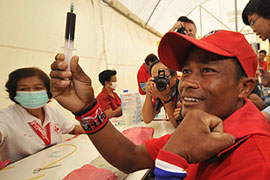Thai demonstrators ‘draw blood’
Red Shirt protesters say they will splatter government buildings with their own blood.

Over the weekend, as many as 100,000 Red Shirts converged in Bangkok to demand that the prime minister, Abhisit Vejjajiva, dissolve parliament by a deadline of midday on Monday and call new elections.
Government rejection
But Abhisit has rejected the ultimatum and imposed a security blanket across the capital.
| in depth | |||||||||
|
“A decision cannot be made between protesters and the government, because it is related to the whole country,” he said on national television on Tuesday,
He said that “dissolution must happen on the condition that it will make the country move forward”.
A joint session of both houses of parliament on Tuesday was postponed due to the lack of a quorum, with some legislators fearing for their safety, according to a Thai parliamentary official.
The Red Shirts claim the current government is illegitimate and is propped up by anti-democratic forces in the Thai military and elements within the traditional ruling class.
Weng Tojirakarn, a protest leader and doctor, said the blood-letting plan would test Abhisit’s conscience.
“Now that people have agreed to sacrifice their blood like this, how can he not make a sacrifice by dissolving the parliament?” he said.
Test of wills
Al Jazeera’s Wayne Hay reporting from Bangkok said the actual turnout on Tuesday afternoon was about 30,000 Red Shirts, a number far lower than the “one million man march” touted by protest leaders earlier.
“The reason they say they are going to do that [the blood protest] is to try to force cabinet ministers … members of the government to have to walk over the blood of the people to get inside Government House.
|
“If Abhisit is still stubborn, even though he does not have blood on his hands, his feet will be bloodied with our curses” Nattawut Saikur, Red Shirt protest leader |
“They say the numbers are slightly down. They were hoping to get one million cubic centimetres of blood, now they’re planning to get about 100,000 cubic centimetres,” he said.
Protesters plan to spill more blood at the headquarters of the ruling Democrat Party and Abhisit’s house if their demands are not met.
In 2008 the compound around Government House was occupied for three months by anti-Thaksin supporters known as the People’s Alliance for Democracy (PAD) or, more popularly, as the yellow shirts.
The Red Shirts were expected to get close enough to the building to throw the bottles of blood, but not force their way into the grounds as promised by red shirt leaders in recent weeks.
“If Abhisit is still stubborn, even though he does not have blood on his hands, his feet will be bloodied with our curses,” Nattawut Saikur, a protest leader, said.
‘Unhygienic’
Thai officials have condemned the blood protest, saying it could spread disease.
 |
| The blood protest has been criticised as unhygienic and wasteful [EPA] |
“Experts are worried and concerned that protesters could contract diseases using needles for blood drawing,” Jurin Laksanawisit, the Thai public health minister, said in a statement.
But protest organisers insisted the procedures were safe, using one needle per person.
“We have three tents for blood donations, Weng Tojilakarn, a senior Red Shirt leader and a doctor, said.
“All people who conduct the blood drawing will be doctors, nurses or other qualified people who came here voluntarily.”
The Thai Red Cross also criticised the plans saying it was wasteful and unhygienic.
Dr Ubonwon Charoonruangrit, a senior official of the Thai Red Cross Society, said she was worried about the risks of untrained people drawing blood, as well as the effects on people who had been out protesting in the heat with little sleep.
She said that one million cubic centimetres of blood “can save many lives”.
Political crisis
Thailand has been in constant political turmoil since early 2006, when protests against Thaksin, the then prime minister, paved the way for a bloodless coup removing him from power.
In 2008, when Thaksin’s political allies came back to power for a year, thousands of yellow shirt protesters took to the streets, occupying the compound of the prime minister’s office and laying siege to Bangkok’s two airports for a week.
Thaksin himself has addressed his supporters through video messages, urging them to continue their struggle in a nonviolent fashion.
In a message on Monday the former prime minister, who is living in exile, called for lawmakers, soldiers, policemen, judges and members of the bureaucracy to join the red shirt cause.
Charnvit Kasetsiri, a Thai historian, said Abhisit’s government has not come out ahead in the ongoing crisis.
“The fact that the prime minister has to resort to staying at the military base and nobody is aware of his whereabouts now indicates that the situation isn’t looking good,” he told the Associated Press.
“The Red Shirts’ plan to pour blood is both symbolic and dynamic. They won’t back down that easily.”
